- Premium features included
- No hidden costs or usage limits
- Scale from startup to enterprise


Back in 2012, Klaviyo entered the email marketing arena and has thus grown into a marketing automation giant with a customer base just shy of 200,000.
What makes Klaviyo different from your typical email platform? While other platforms dabble in analytics, Klaviyo puts real-time customer data and AI-powered personalization at the core of everything it does.
One of the first things that stands out about Klaviyo is that there’s no coding required. Couple this with their product recommendations and surprisingly responsive customer support, and you’ve got a pretty compelling deal.
So whether you’re searching for a solid ecommerce email marketing solution or thinking, ‘Is Klaviyo worth it?’, this review should answer all those burning questions.
Klaviyo is a marketing platform built to help ecommerce merchants connect with customers in a more personal way. It pulls together customer data from purchases, browsing, and engagement so you get a clear picture of who your audience really is. It’s packed with an easy drag-and-drop editor, predictive AI and ready-made workflows that react to customer behavior in real-time.
On top of that, powerful segmentation and predictive tools let you target based on things like repeat purchase likelihood or churn risk. With built-in reporting tied to revenue and integrations with Shopify, WooCommerce, and other popular ecommerce tools, Klaviyo has carved out a strong position in the omnichannel marketing market.
If you want the short verdict, here’s our expert take on Klaviyo for 2026:
Scroll down for a detailed price and feature breakdown.
Before we start breaking down Klaviyo’s features one by one, here’s a quick rating (out of five) based on how each one felt in practice—just to give you a sense of what we’re dealing with here.
Category
Rating
Ease of Use
4.2/5
Email Editor
4.5/5
Email Templates
4.5/5
A/B Testing
4.7/5
Automation (Flows)
4.8/5
Segmentation
4.7/5
Predictive Analytics
4.6/5
SMS Marketing
4.3/5
WhatsApp & Push
3.8/5
Forms & Pop-ups
4.2/5
Landing Pages
2.5/5
Subscriber Management
4.4/5
AI Tools
4.3/5
CRM Functionality
4.0/5
Ecommerce Features
4.8/5
Integrations
4.6/5
API & Webhooks
4.5/5
Reporting & Attribution
4.7/5
Deliverability
4.3/5
Customer Support
4.0/5
Pricing (Value for Money)
3.6/5
Overall Score
4.5/5
Forget boring mass emails—Klaviyo’s got A/B testing that actually works, dynamic content that adapts, and segmentation tools that make your email marketing campaigns click.
What impressed me during testing were the personalization options. Beyond just dropping someone’s name in a subject line, you can pull in merge tags, AI-powered product recommendations, and dynamic blocks that shift based on customer behavior, helping boost engagement with every send. Of course, that’s pretty much expected from any email marketing solution today, but it’s still great to see.
The analytics are noteworthy as well. Real-time stats on opens, clicks, and conversions, plus click-maps that highlight where subscribers engaged most. One underrated gem? Being able to compare campaigns side-by-side via Klaviyo’s reporting dashboard—simple, but super valuable nonetheless.

Klaviyo’s email editor is one of the better ones I’ve used in a while. The drag-and-drop email builder is intuitive, with reusable blocks and more than 350 solid templates that make campaigns quick to build. I like being able to mix in custom HTML, embed product images or videos, and preview personalization in real time. The AI copy tools are handy for saving some time as well.
That said, Klaviyo’s email builder, which experienced a noticeable upgrade since last time, can feel clunky—blocks occasionally misbehave, mobile editing is rather painful (something most email marketing services are guilty of) and scaling padding now requires typing in values, instead of clicking the up/down button.
Klaviyo’s split testing tool doesn’t do anything crazy other email marketing platforms don’t already do, so you pretty much get what you’re expecting. You can experiment with almost every part of your email—subject lines, sender names, content blocks, CTAs, and even send times. It feels like a proper testing environment rather than a checkbox feature.
What I liked most was how easy it was to spin up variations. You can duplicate an email version with one click, tweak whatever you want, and Klaviyo automatically splits your audience based on your chosen distribution. Now, it’s not perfect. While it’s great for email campaigns, I wish Klaviyo offered the same level of flexibility in flow-based A/B tests. Flow splits work fine, but they’re more limited and a bit clunky to analyze compared to the cleaner reporting in campaign tests.
Klaviyo’s email templates give you a strong head start. There’s a library of 350+ professionally designed template options covering everything from promos and newsletters to seasonal campaigns ready to display product images, all of which you can tweak with the drag-and-drop editor.
You can set global brand styles—logos, fonts, colors—so every email stays on brand, and save universal content blocks for reuse across campaigns. If you want more control, you can combine HTML with visual blocks in hybrid templates, mixing the best of both worlds.
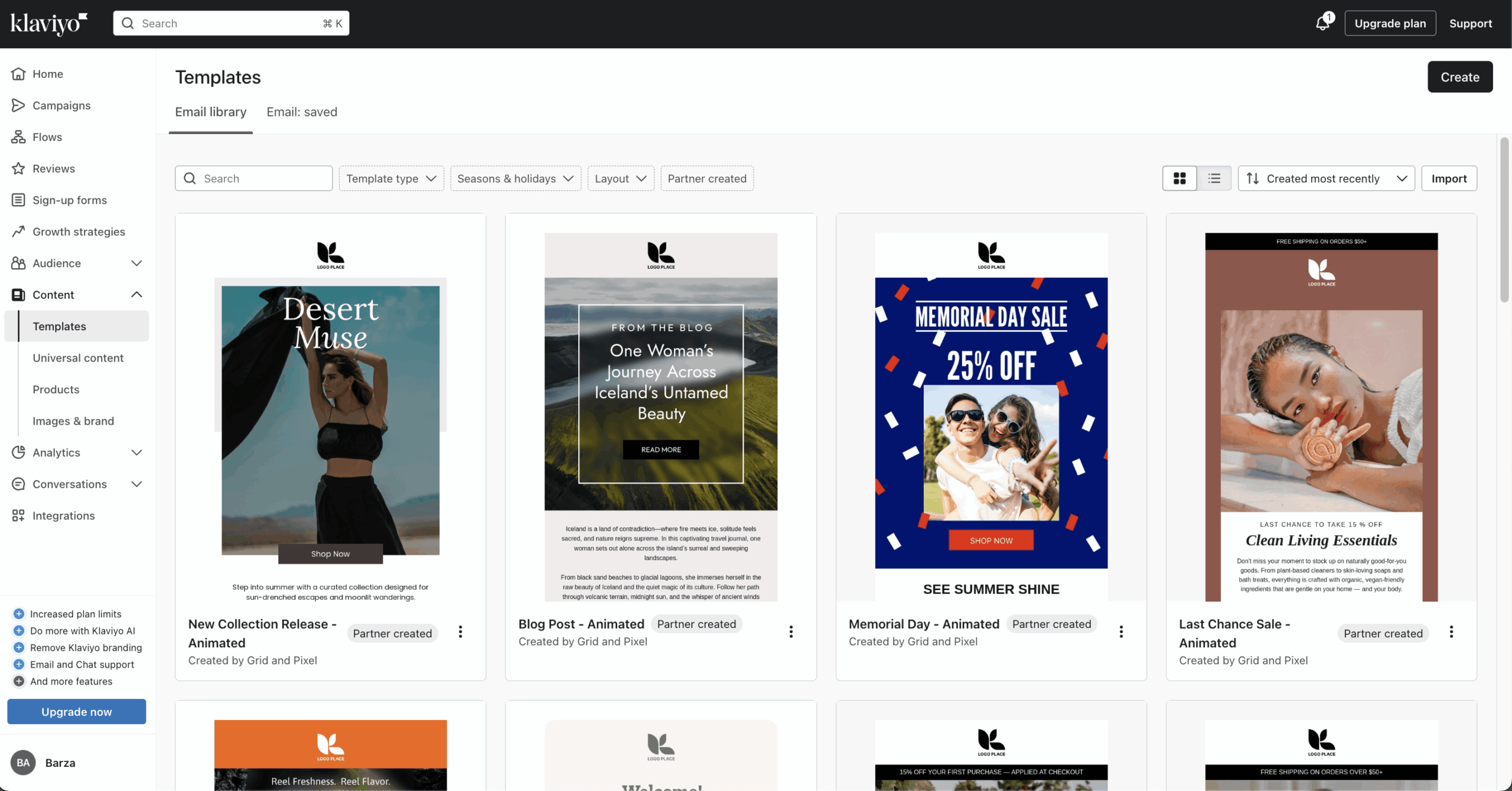
Look, I’ve tried dozens of email marketing automation tools, and most of them are either too basic or so complex you need a PhD to use them. Klaviyo marketing automation, meanwhile, sits in that sweet spot in between.
They’ve got 70+ pre-built workflows for common scenarios, and their Automations Library makes it easy to browse, preview, and launch proven, high-performing flows without starting from scratch. Another great thing is that you can also build custom journeys from zero, creating workflows that deliver personalized experiences.
Klaviyo’s Campaign Planner is a nice addition too. It helps map out campaigns around holidays, product launches, and high-intent moments, so you’re not scrambling to figure out what to send and when at the last minute. Plus, it’s equipped with an AI-powered assistant which occasionally drops some nifty insights.
That said, I do have a couple of gripes with Klaviyo’s automation. It took me the better part of an afternoon to wrap my head around setting up more complex workflows, and even now—multi-branch flows can feel a bit clunky to design and maintain. At least now Klaviyo allows contacts to re-enter list-triggered flows more than once, which wasn’t the case last time I checked.
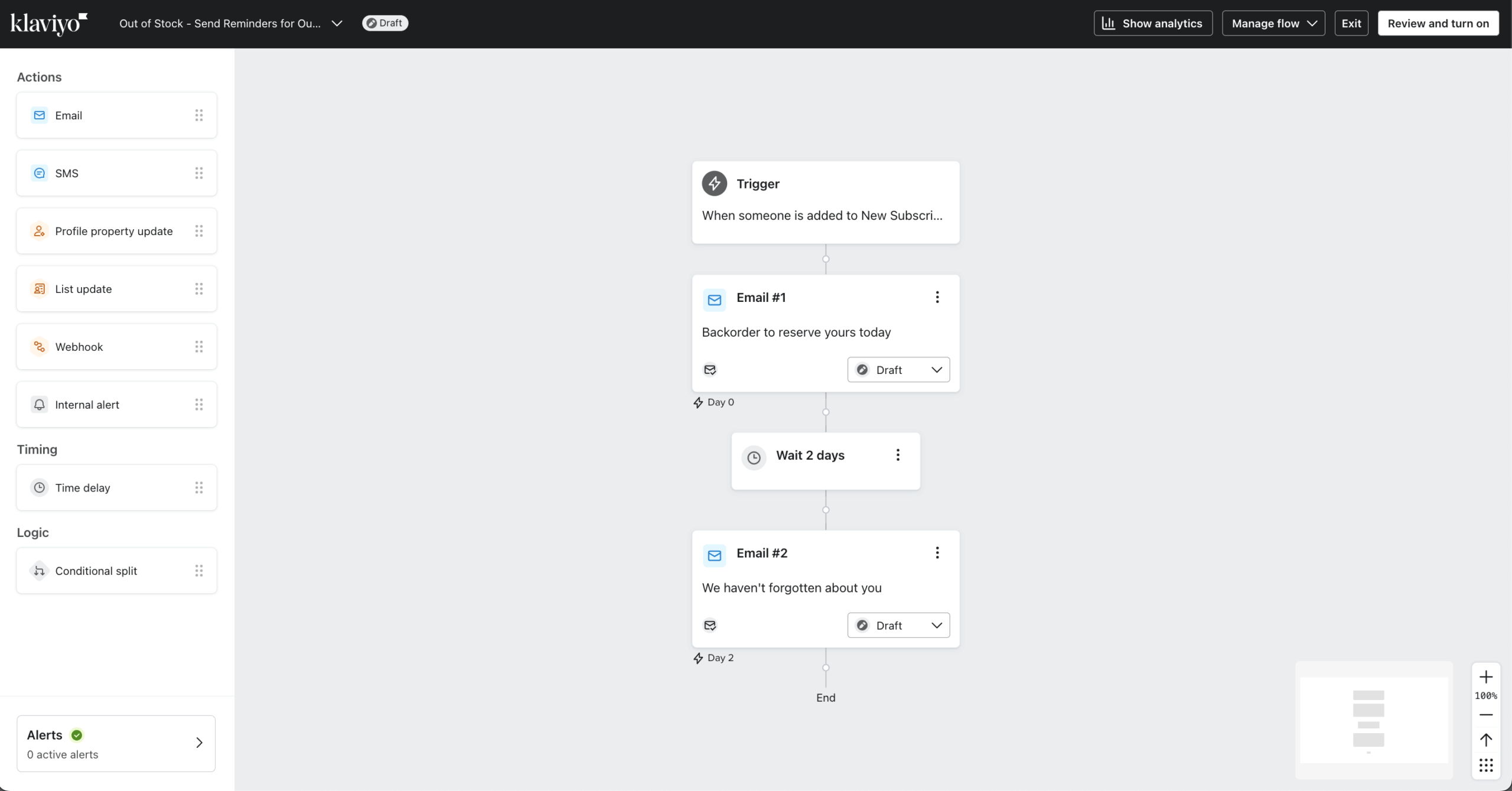
Klaviyo’s deliverability track record is generally solid, and it comes with a strong set of tools to help keep emails landing in the inbox. The Deliverability Hub, for instance, is like the email marketing equivalent of credit score and in Klaviyo’s case it’s very detailed—to the point where you can drill down into metrics like bounces, unsubscribes, and spam complaints for each campaign or flow, with a detailed event log available for tracking.
The built-in recommendations for domain authentication and list hygiene are noteworthy features, too. Still, while I’ve not had any issues with deliverability myself, I’ve seen some users mention their performance slipping below benchmarks even with the correct setup.
I’ve been using Klaviyo’s SMS messages alongside email marketing, and the biggest advantage is having everything under one roof. Segments, flows, and analytics all work seamlessly across both channels, which makes it easy to run unified campaigns.
Klaviyo has also expanded into WhatsApp and push notifications, which helps round out its multichannel offering, though these features are still maturing compared to its core email/SMS tools. They’re solid for basic automations, but power users may find the customization and analytics a bit limited.
That said, there are some limitations worth considering—advanced testing and SMS-specific features, including segmentation depth and message-level A/B testing, don’t feel as polished as on dedicated tools like Postscript (which does integrate smoothly with Klaviyo).
Still, in my opinion, the convenience of managing email and SMS under the same dashboard outweighs the minimal trade-offs.
Klaviyo isn’t winning any awards for its landing page builder—because it’s non-existent. The good news is that Klaviyo plays really nicely with tools like Unbounce and Leadpages. So if you’re already using a dedicated landing page builder for your website, the integration is relatively smooth.
On top of that, Klaviyo does a solid job of handling full-page website sign-up forms (which don’t require any extensions).
Where Klaviyo does pull its weight is with signup forms and pop-ups. It has 70+ pre-made sign-up form templates ready to build on and be embedded to your site. They’re surprisingly solid, with dynamic content options, behavior-based triggers like exit intent, and audience targeting baked in.
The only drawback is the limited flexibility when it comes to editing HTML or embedding forms directly in Klaviyo’s form builder without JavaScript. Not a deal-breaker, but something worth considering.
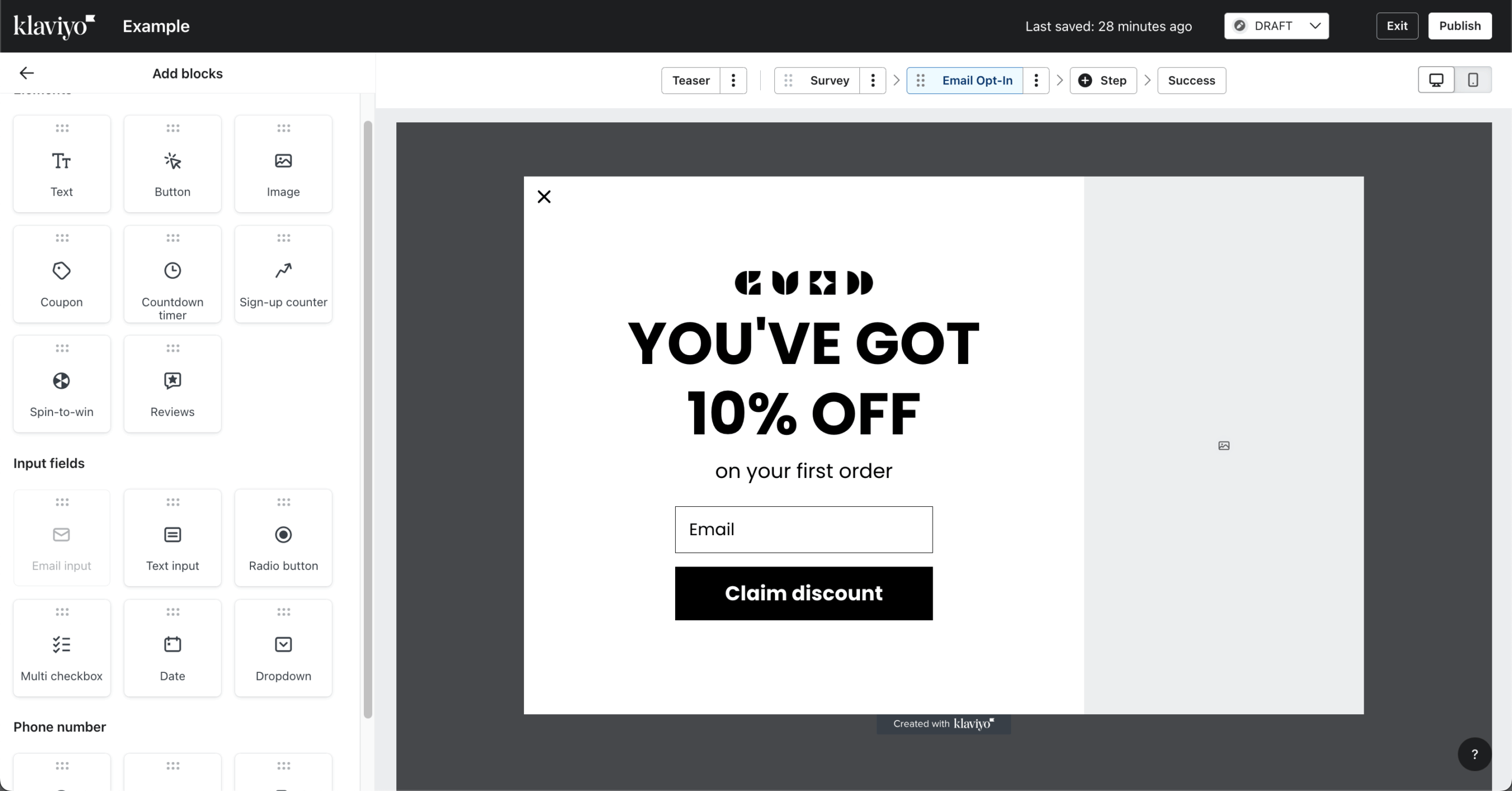
What I really like about Klaviyo’s segment builder is how much stronger this feature feels compared to cheaper Klaviyo alternatives. I could set up specific audience segments—like “VIP customers who browsed Product X in the last 3 days but didn’t purchase”—without much effort. Personalization also goes way beyond just dropping in someone’s first name, too.
Another big win for Klaviyo is being able to dig deep into historical data to spot long-term behavior trends. The only downsides I’ve run into are that Klaviyo’s pricing grows pretty quickly as your list gets bigger, and segmentation can get a bit messy if you’re not careful. Once you’ve got dozens of overlapping segments or inconsistent naming, it takes real discipline to keep everything tidy.
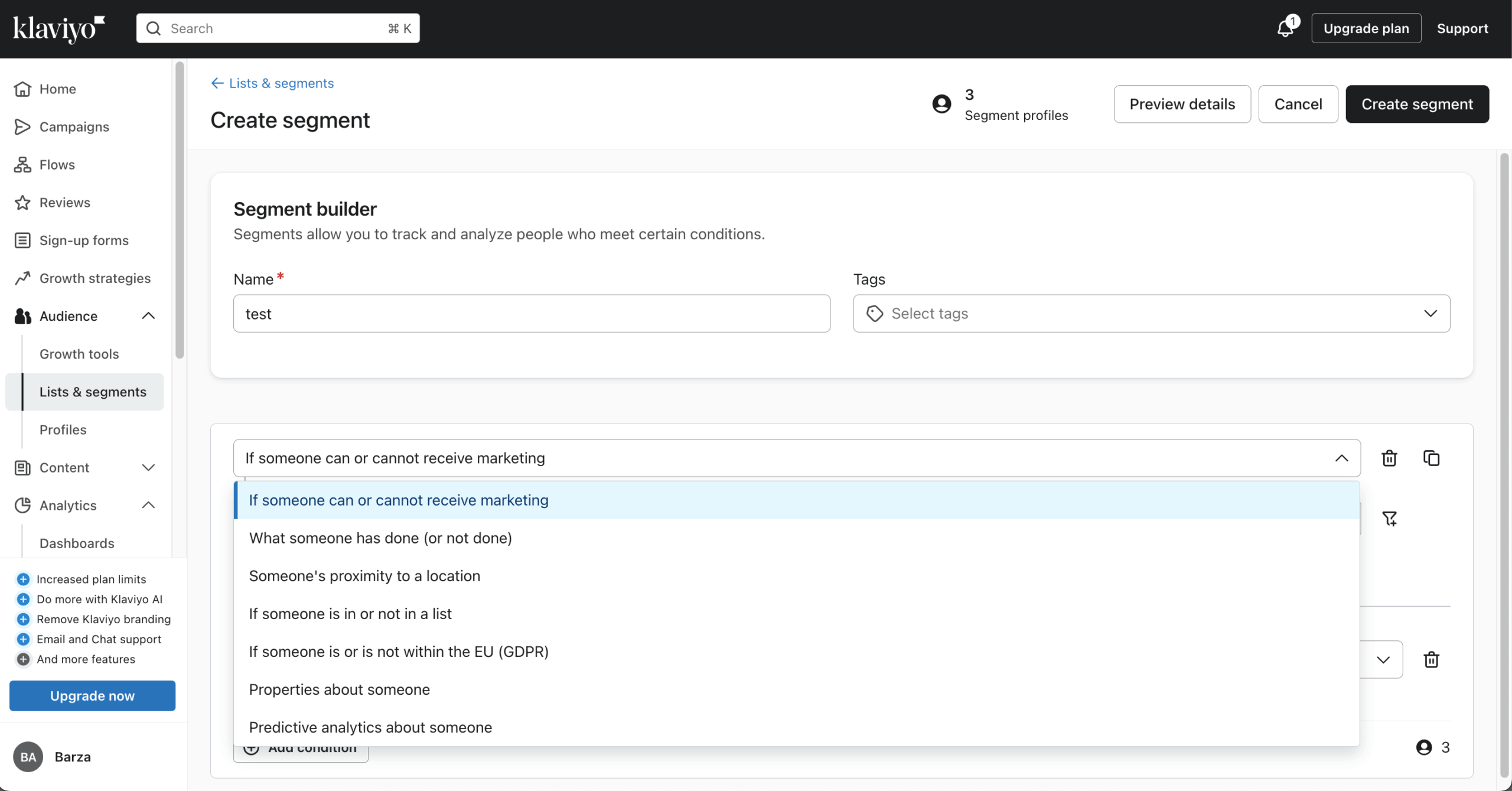
Klaviyo’s AI features have been a real time-saver for me. Segments AI is probably my favorite—I can just type what kind of audience I want, and it builds the segment instantly. While Flows AI is also handy, especially when I don’t feel like mapping out every branch—it’s still finicky and in need of improvement, but does the job alright.
The predictive analytics are impressive too, particularly with churn risks and expected order dates, which make targeting so much smarter. Even the AI copy suggestions in the email editor helped when I was stuck or too tired to come up with something original myself. It’s not perfect, but overall, Klaviyo’s AI is a move in the right direction.
If you run an ecommerce shop, Klaviyo’s CRM feels like a home run—real-time syncing from Shopify store or WooCommerce gives you rich customer profiles and razor-sharp segmentation (I’ve pinpointed churn risk and next-order predictions without extra tooling). Automation flows fire beautifully, and revenue-linked reports make ROI clear.
Now, compared to heavy-hitter CRMs like HubSpot or Zoho, Klaviyo leans lighter—it doesn’t offer pipelines or deep B2B workflows, unfortunately. Still, it wins if you want the smartest, most intuitive marketing engine for Direct-to-Consumer (DTC) approach. Just be ready: those contact-based pricing tiers can climb fast as your list grows.
Klaviyo for ecommerce has been a real game-changer, since it pulls in real-time data from Shopify and makes it easy to run targeted flows like abandoned cart reminders, post-purchase emails, and back-in-stock alerts. I also enjoyed their dynamic product feeds and integrations with reviews widgets, that let you automate Klaviyo review requests after purchase—a nice boost to personalization.
However, it’s not perfect—pricing climbs quickly as your list grows, and setting up more complex triggers can get messy. Still, for ecommerce store owners that want deep integrations and proven revenue impact, Klaviyo is hard to beat.
Klaviyo’s transactional emails surprised me in a good way—they’re far more flexible than what most ecommerce platforms bake in. I loved being able to design order confirmations, shipping updates, and password resets using the same drag-and-drop editor I use for campaigns, which keeps everything consistent and on-brand.
The real win, though, is how deeply transactional messages tap into customer data. You can pull in product blocks, recommendations, or dynamic order details without touching code.
That said, setting everything up requires some technical steps, especially if you’re replacing your store’s default system emails. Once configured, though, Klaviyo’s transactional emails feel powerful, reliable, and noticeably more polished than the standard out-of-the-box options most ecommerce tools provide.
Klaviyo’s product reviews management (simply called ‘Klaviyo Reviews’) feels smooth if you’re already running your store through Shopify or WooCommerce. I could plug in third-party review apps and automate post-purchase review requests using Klaviyo flows.
Setting it up was straightforward: once I installed the add-on, I could collect user feedback, moderate submissions inside Klaviyo, and even import older reviews from a previous platform—all without lifting a finger.
Display options are better than I expected. You can drop star-rating badges under product titles, embed full review lists or media-rich carousels onto product pages, or publish an all-reviews page for extra social proof. The widgets are clean, customizable, and don’t require extra apps unless you need something ultra-specific.
Pricing is add-on based, starting at $25/month and scaling upwards with order volume which feels fair, but can quickly add up if you’re processing lots of monthly orders. Overall, if you’re already deep in the Klaviyo ecosystem, the convenience and data integration easily outweigh the extra cost.
If you’re running an ecommerce store, you’ll love Klaviyo’s integration setup. One-click connections with WooCommerce, BigCommerce and Shopify app store—they’ve got all the big players covered. Everything syncs in real-time—the only exception being Magento, taking around 10 minutes to sync on average, which isn’t something major anyone should complain about.
Klaviyo API is flexible too, letting you import data from CRM systems, inventory tools, analytics dashboards, etc. The event-based triggers work across all your connected platforms, which means you can focus on creating unified customer experiences without a ton of technical headaches. The same goes for ability to display reviews pulled in from third-party tools.
The webhooks and data mapping features make custom workflows possible, even if you’re using some niche tools alongside the mainstream ones.
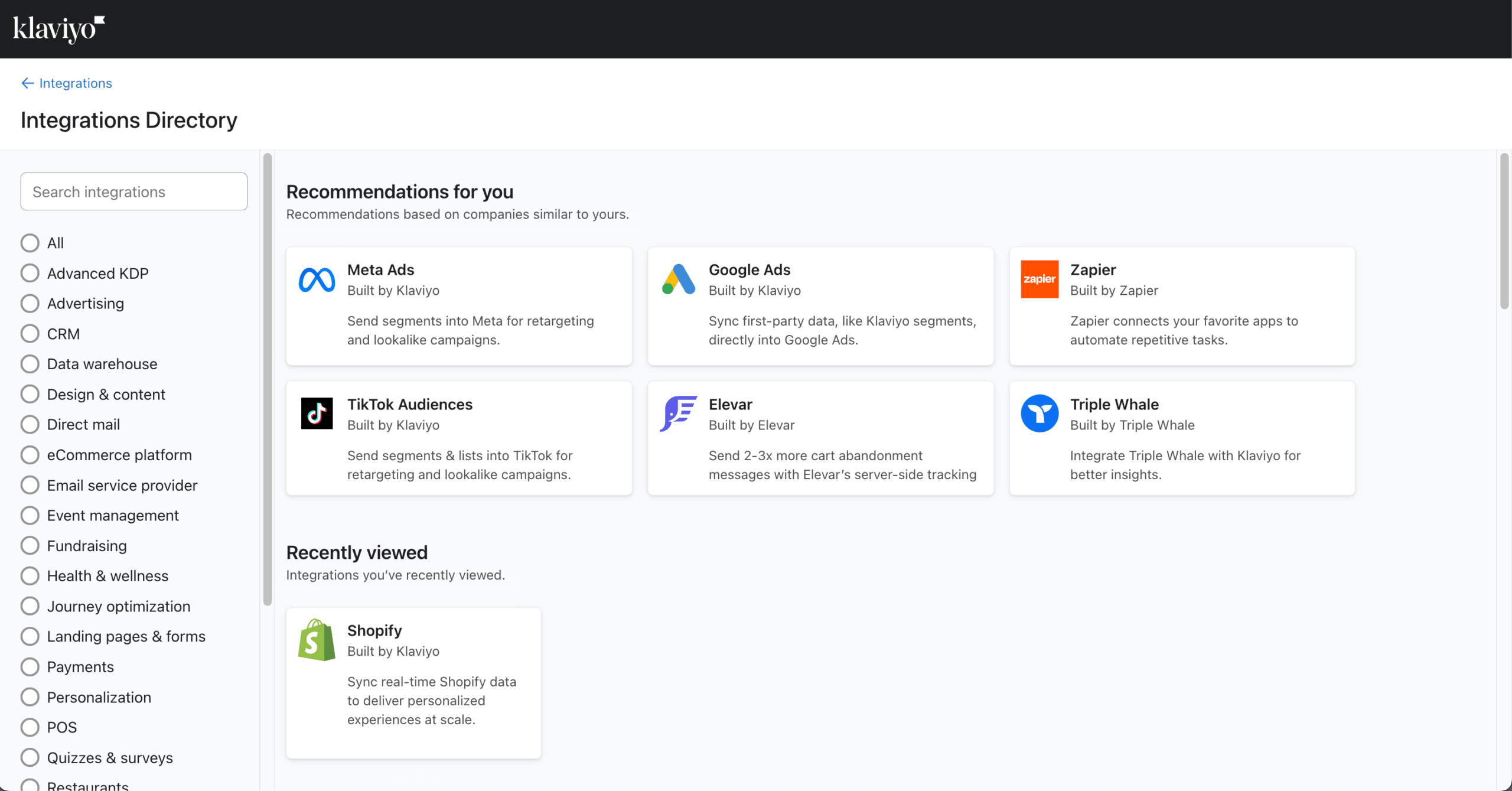
Let’s face it—most email marketing analytics don’t go far beyond opens and clicks. However, Klaviyo takes a different approach, focusing on revenue attribution and actionable insights. You get real-time tracking of opens, clicks, conversions, and (most importantly) the actual money generated from each campaign.
Cohort-based retention reports helped me understand long-term customer value. I could break performance summaries down by segment, product, or time period—only a few email marketing platforms can match that.
Klaviyo also supports different attribution models (like last-touch or multi-touch), giving you a more accurate picture of what’s really driving revenue. The custom report builder makes it easy to visualize trends across multiple data points and quickly find answers to those burning performance questions.
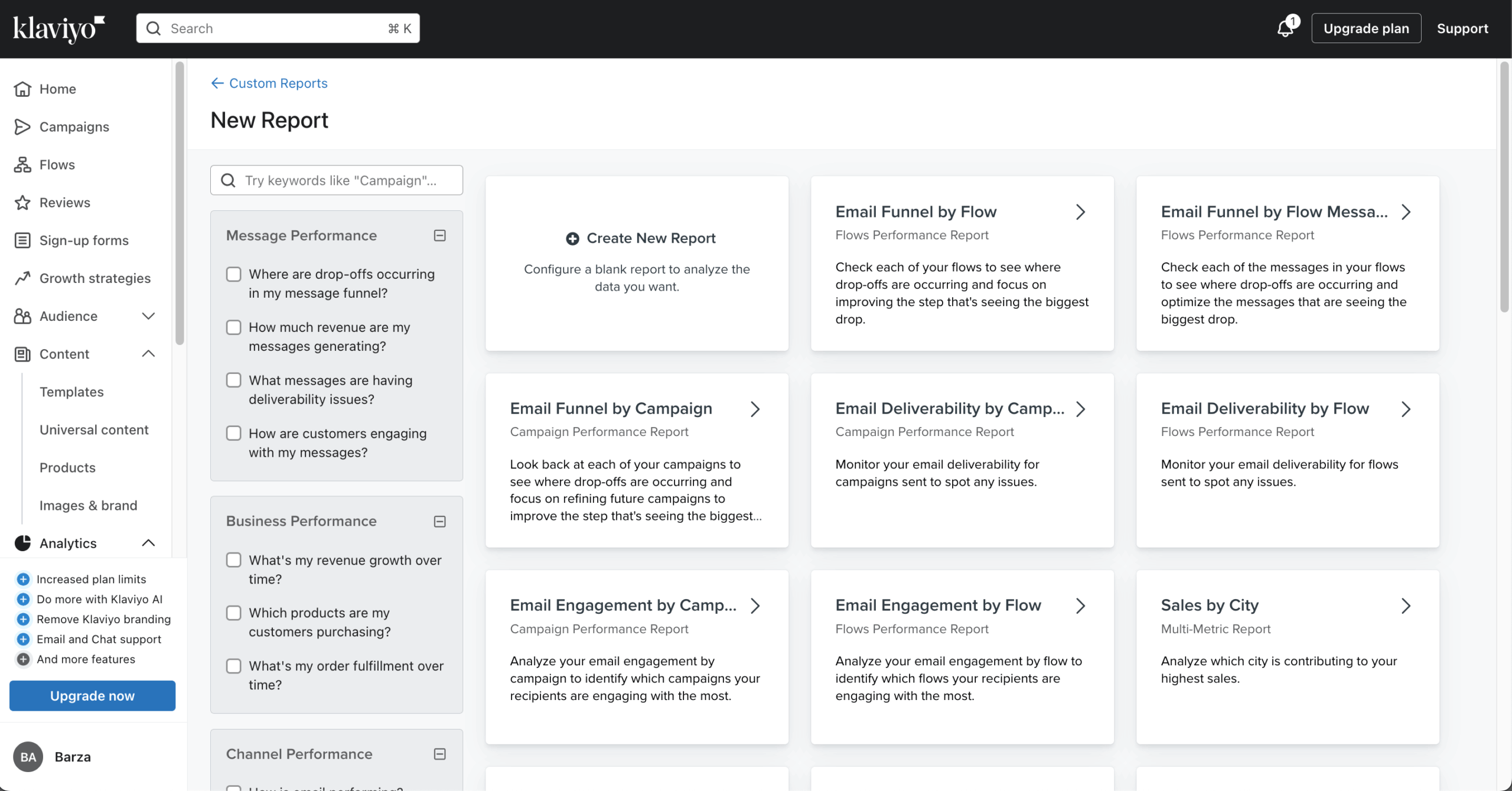
Unlike some competitors who treat support as an afterthought, Klaviyo actually seems to care about helping you succeed—and this goes a long way to trust building.
For starters, paid users get 24/5 live chat and 24/7 email help (free plans only get email support for the first 60 days) any day/night of the week, plus access to the Help Center, live training, and Klaviyo Academy, where you can earn certificates while setting up your deliverability or omnichannel strategy.
If you’re on the Email + SMS plan, you also get access to Klaviyo’s Growth success team, which I haven’t had a chance to interact with. The only drawback? Klaviyo doesn’t offer phone support, which can be a deal breaker for users who don’t have the patience nor time to deal with live-chats.
Free
Email+SMS
$0
Forever free
$20
per month
$20
per month
What impressed me most about Klaviyo is how seamlessly it turns data into action. Its tight Shopify integration makes advanced segmentation feel effortless, and real-time syncing ensures campaigns stay relevant as customer behavior changes.
Meanwhile, the visual automation builder keeps even complex logic approachable, which makes building smarter flows far less intimidating. Deliverability has been rock-solid (at least from my experience, which contradicts with what half of Klaviyo users report), and the A/B testing tools go well beyond simple subject line tweaks.
I also appreciated the custom analytics dashboards—they surface insights you can actually use to optimize performance, rather than just showing numbers for the sake of it.
Klaviyo isn’t perfect, and a few things stood out during my time with it. Pricing climbs fast as your list grows, which can sting if you scale quickly. For newcomers, there’s a definite learning curve—it takes some time to get comfortable. Support is helpful but clearly prioritizes paying users on higher tiers, which isn’t a case with Klaviyo alternatives like Sender or Omnisend.
Outside of ecommerce, integration options feel a bit thin, and the template editor can be glitchy at times with less design flexibility than I’d like. And if you want deep customization, be ready to get into the code (or hire someone who will).
Perfect For
Look Elsewhere if You’re
Ecommerce brands on Shopify/BigCommerce
Real-time data syncing enables personalized automation
Content creators and bloggers
Lacks the specific tools and monetization features you need
Mid-sized DTC brands focused on attribution
Built-in revenue tracking shows clear ROI
Startups on tight budgets
Costs rise quickly as your list grows
Marketing teams with technical resources
Robust API and customization options enable advanced workflows
Non-ecommerce businesses with niche requirements
Limited integrations outside retail platforms
If you’re running an online store, particularly through Shopify, Klaviyo is pretty much a no-brainer. The real-time data syncing enables personalized, timely automations that would be complicated or impossible elsewhere. When customers abandon carts or browse specific products, you can trigger perfectly timed follow-ups.
Of course, its omnichannel marketing approach extends beyond email into SMS, push, and even integrations with ad platforms, letting you keep messaging consistent across every channel.
Marketing teams focused on revenue attribution will appreciate how clearly Klaviyo connects email performance to actual sales. Metrics like revenue per recipient and flow-generated revenue provide insights that actually help you optimize your strategy.
If you’re not selling products online, Klaviyo might be overkill. Non-ecommerce businesses like SaaS startups or educational platforms will find features they don’t need, like abandoned cart flows, product feed recommendations, and predictive purchase timelines, and miss integrations they actually could use. The platform is clearly optimized for product-based businesses, with limited options outside that ecosystem.
Solo creators, bloggers, and small businesses might struggle with both the complexity and cost, so switching to something more light-weight makes sense. The learning curve gets steep without a dedicated marketing person, and the price jumps significantly even with modest list growth. These folks might be happier with simpler, more affordable options like MailerLite or Sender.
Many G2 existing reviews praise Klaviyo for its intuitive UX, productivity-focused design, and powerful customization options for emails and flows. One Klaviyo review highlights how seamless the platform feels when integrated with Shopify or BigCommerce, noting that tasks usually take just a click or two.
That said, users also flag drawbacks. One rather negative review mentioned that segment loading can be painfully slow compared to lighter tools, and occasional glitches—like overlapping fields when exporting—can interrupt workflows. A few Klaviyo reviews mention that setting up segments isn’t always intuitive and that navigating Klaviyo’s large help library can feel overwhelming without dedicated support.
Klaviyo earns praise for its advanced segmentation, automation, and analytics, getting star ratings in particular for its ecommerce marketing functionality. In one review, Klaviyo Shopify integration is noted as a key benefit, enabling highly personalized campaigns that improve engagement and conversions.
Features like customizable templates, Klaviyo SMS marketing, automated review requests, and an expanding ecosystem of complementary tools add to its appeal, especially for businesses upgrading from platforms like Mailchimp or Constant Contact.
Despite the praise, many reviewers consider pricing one of Klaviyo cons, with costs climbing quickly as subscriber lists grow. One review also mentions occasional deliverability concerns, a steep learning curve for beginners, and limited human support. Still, most agree it’s one of the best platforms for ecommerce-focused brands, particularly for automating review requests with an incentive.
Reddit users often highlight Klaviyo’s biggest strength—it’s built specifically for ecommerce. Unlike general-purpose tools, it pulls in real customer and order data from platforms like Shopify, WooCommerce, and BigCommerce—one review claims. Many also like revenue-focused reporting, which ties campaigns directly to ROI.
However, some reviews feel Klaviyo isn’t the obvious choice it once was. Costs have climbed, and smaller brands may find the advanced features underused compared to cheaper tools like Omnisend or MailerLite. Another Klaviyo review mentions struggles with low engagement, often linked to list quality and segmentation practices.
In the end, Klaviyo stands out as a premium email and SMS marketing ecommerce platform. Its strengths lie in powerful automation, AI-driven personalization, deep Shopify and WooCommerce integrations, and detailed revenue-linked reporting that shows real ROI.
The drag-and-drop editor, 350+ templates, and predictive analytics make it easy to craft targeted, high-performing campaigns.
However, pricing scales quickly as lists grow, support prioritizes paid tiers, and the learning curve can challenge beginners. Still, for digital stores seeking data-driven flows, advanced segmentation, and unified customer experiences, Klaviyo remains one of the best offers you can find today.
Klaviyo vs. Mailchimp
When it comes to Klaviyo vs. Mailchimp, both are solid email marketing tools, but they’re built for different audiences. Klaviyo is laser-focused on ecommerce with deep integrations into Shopify and similar platforms. While Mailchimp takes a more general approach, making it better for non-ecommerce users like bloggers, consultants, and nonprofits. If you want real-time triggers, predictive analytics, and advanced flows, Klaviyo is the hands-down winner.
Klaviyo vs. Omnisend
Both email marketing solutions target ecommerce but come with different strengths. For instance, Omnisend is great for small teams who want quick multi-channel campaigns without complexity. On the other hand, Klaviyo beats Omnisend in the Klaviyo vs. Omnisend debate for B2C businesses because of its detailed data and reporting access that justify the higher price.
Klaviyo vs. ActiveCampaign
ActiveCampaign excels at CRM-driven email marketing, making it more suited for service businesses, B2B companies, and complex sales processes. And while ActiveCampaign offers broader automation across sales and marketing, it lacks Klaviyo’s ecommerce analytics and prediction tools. For digital stores debating Klaviyo vs. ActiveCampaign, Klaviyo is the no-brainer answer—especially if you rely on integrations with a reviews app to build trust.
Yes, Klaviyo is worth the cost for small ecommerce businesses. It offers advanced automation, dynamic segmentation, and AI-driven product recommendations tailored for online stores. Its deep integrations with Shopify, WooCommerce, and other platforms help personalize campaigns and recover abandoned carts, with many users reporting over 20% of sales attributed to Klaviyo campaigns.
Learning Klaviyo’s advanced features typically takes at least a week of consistent use. Basic email and SMS flows can be set up within days, but mastering workflows, segmentation, A/B testing, and predictive analytics usually requires more time. Many Klaviyo users find the platform intuitive, supported by tutorials, templates, and training resources, meaning small ecommerce teams can become proficient without needing dedicated technical expertise.
Yes, Klaviyo offers top-tier monitoring and insights that support strong inbox deliverability. With features like account-level deliverability scores, domain analytics, bounce tracking, and a detailed Deliverability Hub to monitor email health and sender reputation, Klaviyo deliverability is solid for the price you’re paying. That said, email marketing platforms like Sender offer deeper diagnostics and reporting tools, giving marketers more visibility and control over the deliverability.
